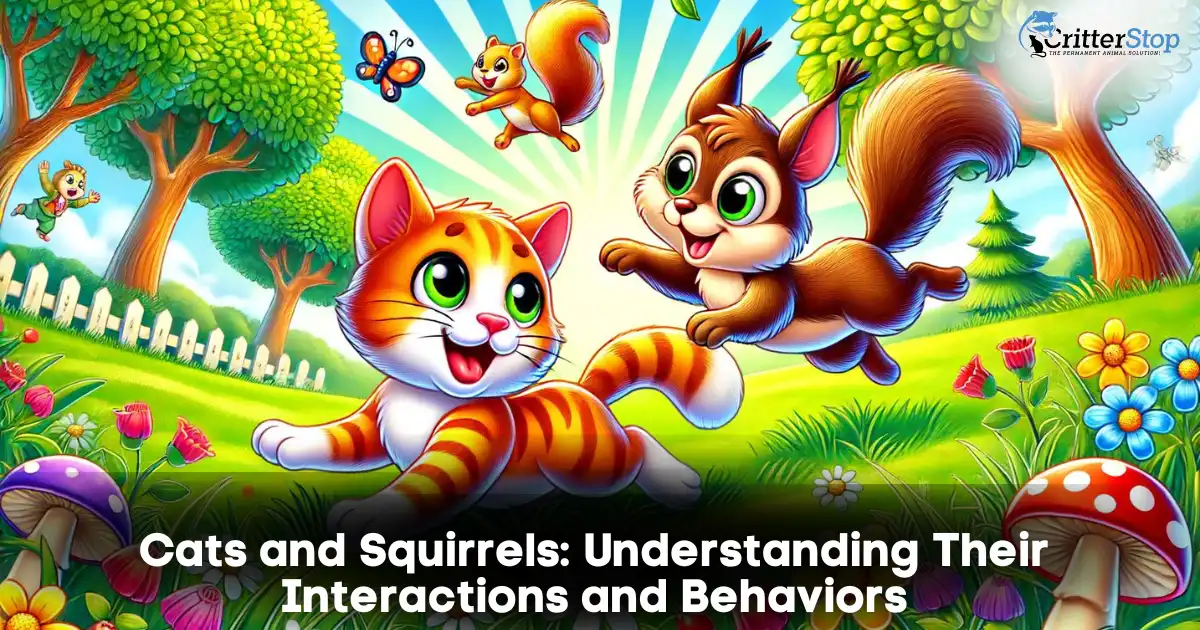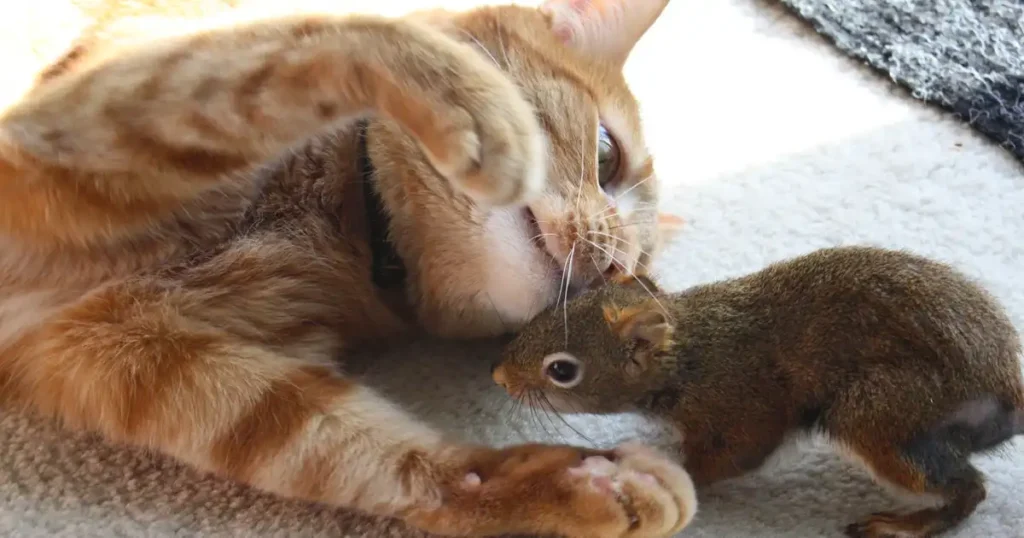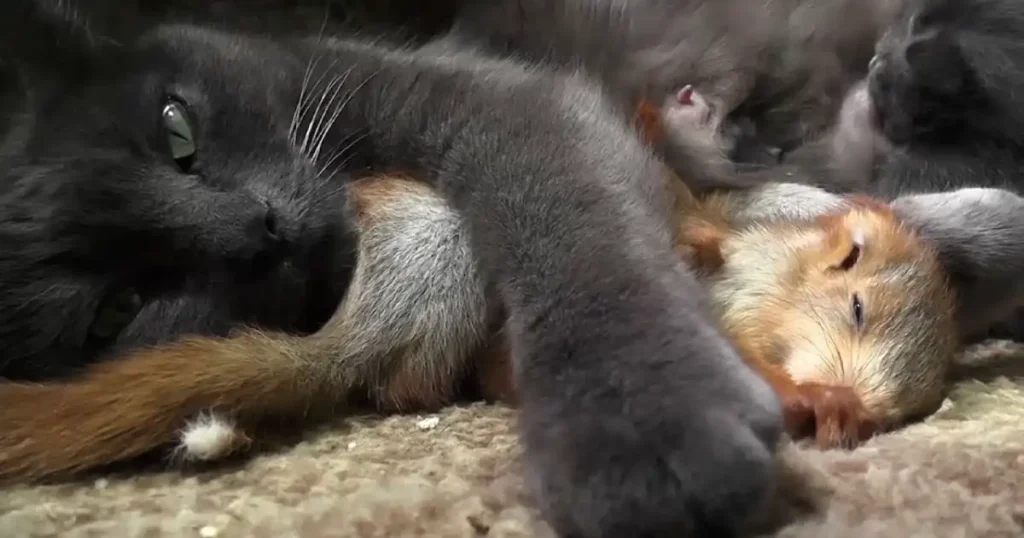
The relationship between cats and squirrels is a fascinating topic for many pet owners and wildlife enthusiasts. While cats are known for their predatory nature, squirrels are agile and quick, making their interactions a blend of curiosity, instinct, and survival. In this comprehensive article, we will delve into the dynamics of squirrels and cats, exploring their behaviors, potential risks, and how to manage their coexistence in your yard or home.
Understanding these interactions is crucial for ensuring the safety and well-being of both animals. Cats, being natural hunters, often see squirrels as potential prey, which can lead to high-energy chases and occasional confrontations. On the other hand, squirrels are adept at evading predators, utilizing their speed and agility to escape. However, these encounters can sometimes result in injury or stress for both animals. By recognizing these behaviors and taking preventive measures, such as supervising outdoor time or creating safe spaces for squirrels, pet owners can promote a more harmonious environment in their yards and homes.

Cats are natural hunters. Their instincts drive them to chase, pounce, and capture smaller animals, including birds, mice, and squirrels. This behavior is deeply embedded in their DNA, regardless of whether they are domesticated or feral. Do cats attack squirrels? Absolutely, and this predatory behavior is a testament to their natural hunting skills.
Cats use a combination of stealth, patience, and quick reflexes to hunt. They often stalk their prey quietly, moving with calculated precision, before launching a swift attack. This hunting behavior is not just about survival but also about stimulation and exercise, especially for indoor cats. Cats chasing squirrels is a common sight, driven by their inherent predatory instincts.
Squirrels, though agile and fast, can become victims of a cat's predatory instincts. While adult squirrels are more adept at escaping, baby squirrels or injured ones are at a higher risk. It is essential for pet owners to be aware of this dynamic in order to protect local wildlife. The risk of cats killing squirrels or cats catching squirrels is significant, particularly in areas where both animals coexist closely.

Squirrels are known for their nimbleness and quick reflexes. They are excellent climbers and can leap significant distances, which often helps them escape predators, including cats. But are squirrels afraid of cats? Yes, their natural instincts make them wary of feline predators.
When threatened, squirrels use a variety of defensive tactics, including:
Squirrels are also equipped with sharp claws and strong teeth, which they use not only for foraging but also for defense if cornered. These attributes make them formidable adversaries, despite their size.
In residential settings, do cats and squirrels get along? Not naturally, but understanding their behaviors can help in managing their interactions and ensuring both animals' safety.
To promote coexistence, consider the following:
Supervising outdoor time for cats can significantly reduce the risks to squirrels. Additionally, training cats to respond to commands or using deterrents can help manage their predatory behavior. This can prevent instances where cats kill squirrels or even the frequent scenario of cats chasing squirrels.

Interactions between cats and squirrels can also pose health risks, primarily through disease transmission. Understanding these risks is crucial for pet owners.
Both cats and squirrels can carry diseases that may be transmitted through bites or scratches. Some common ones include:
To mitigate these risks, ensure that your cat's vaccinations are up to date and consider keeping them indoors or supervised when outside. If your cat catches or injures a squirrel, seek veterinary care immediately.
Cats can have a significant impact on local wildlife populations, including squirrels. Responsible pet ownership is vital to maintaining ecological balance.
Encouraging natural behaviors in cats while protecting local wildlife involves:
Community awareness and involvement in wildlife conservation can lead to better coexistence. Educating neighbors and participating in local wildlife protection programs can make a significant difference.

Ensuring that cats have sufficient behavioral enrichment can significantly reduce their predatory behavior toward squirrels. Cats need mental and physical stimulation to thrive, and providing this within the home environment can curb their hunting instincts.
Investing in a variety of interactive toys can keep cats entertained and physically active. Consider the following:
Cat trees and scratching posts not only provide exercise but also give cats an outlet for their climbing and scratching needs. These structures can simulate a natural environment where cats can climb and perch, reducing their need to chase wildlife outdoors.
Awareness and education are critical in managing the coexistence of cats and squirrels. Pet owners should be informed about the impact their pets can have on local wildlife and the steps they can take to mitigate it.
Hosting community workshops can help educate pet owners on responsible pet ownership. Topics could include:
Creating and sharing online resources such as articles, videos, and infographics can also spread awareness. These resources should cover:
To protect squirrels and other wildlife, adopting wildlife-friendly practices is essential. These practices can be integrated into daily routines and community planning.
Gardening can be tailored to create a safe haven for squirrels while deterring cats from preying on them. Consider:
Working with neighbors to create a wildlife-friendly community can amplify efforts. Initiatives might include:
Understanding the legal and ethical considerations of pet ownership and wildlife protection is crucial. Laws regarding pet control and wildlife conservation vary by region, and staying informed is a pet owner's responsibility.
Familiarize yourself with local regulations concerning:
Beyond legal obligations, pet owners have an ethical responsibility to ensure their pets do not harm local wildlife. This includes:
Modern technology offers various tools and devices that can help manage the interactions between cats and squirrels effectively.
Cat collars with bells can act as a deterrent by alerting squirrels to a cat’s presence. This simple yet effective solution can reduce the success rate of a cat's hunting attempts.
Installing motion-activated sprinklers in the yard can deter cats from entering certain areas. These devices can be particularly useful in protecting bird feeders and squirrel feeding stations.
For pet owners who allow their cats outside, GPS tracking devices can monitor their movements and ensure they are not venturing into areas where they could pose a risk to wildlife. This data can also help in creating strategies to keep pets within safe zones.
Q: Do cats catch squirrels?
A: Yes, cats can catch squirrels. Cats are natural hunters, and their instincts drive them to chase and capture smaller animals, including squirrels. However, squirrels are agile and quick, which often helps them escape from cats.
Q: Do cats like squirrels?
A: While it may seem like cats are interested in squirrels, this interest is primarily driven by their predatory instincts rather than affection. Cats see squirrels as potential prey, so their "liking" is more about the thrill of the chase and the opportunity to hunt.
Q: Do cats and squirrels get along?
A: Generally, cats and squirrels do not get along. Their interactions are often based on the predator-prey dynamic, with cats viewing squirrels as prey. In some rare cases, individual cats and squirrels may tolerate each other, but this is not the norm.
Q: Are squirrels scared of cats?
A: Yes, squirrels are typically scared of cats. Their natural instinct is to avoid predators, and cats pose a significant threat. Squirrels often use quick, evasive maneuvers and high-pitched warning calls to alert others and escape from cats.
Q: Do cats go after squirrels?
A: Yes, cats often go after squirrels due to their strong hunting instincts. Cats enjoy the challenge of chasing fast-moving animals, and squirrels, with their quick movements and agility, provide a tempting target for them.
Sometimes, despite our best efforts, squirrels can become a nuisance or even enter our homes. In such cases, professional help is necessary. Critter Stop is a highly reputable humane wildlife removal company known for its high-quality work and excellent customer service.
Critter Stop offers comprehensive squirrel removal services that are humane and effective. Their team of experts is trained to handle wildlife safely and ensure they are relocated without harm. Customer reviews consistently highlight their professionalism and dedication to quality service.
If you are facing issues with squirrels in your home or yard, we highly recommend contacting Critter Stop for their expert squirrel removal services. Visit Critter Stop to learn more, schedule a consultation, or contact us at (214) 234-2616 to get a free estimate of our services.
Visit our Critter Library and learn more about our furry friends